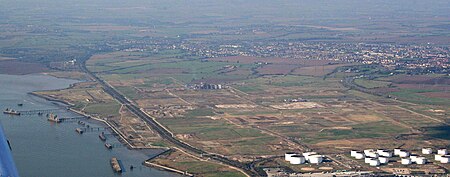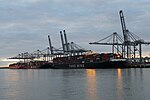Shell Haven
Economy of LondonEngvarB from October 2013History of the petroleum industry in the United KingdomIndustry on the River ThamesInfrastructure in London ... and 8 more
Oil refineries in the United KingdomPort of LondonPorts and harbours of EssexPorts and harbours of the North SeaPorts and harbours of the Thames EstuaryScience and technology in EssexShell plc buildings and structuresThurrock

Shell Haven was a port on the north bank of the Thames Estuary at the eastern end of Thurrock, Essex, England and then an oil refinery. The refinery closed in 1999 and the site was purchased by DP World who received planning consent in May 2007 for the new London Gateway deep water container port at the site. The neighbouring Coryton Refinery remained in operation until 2012.
Excerpt from the Wikipedia article Shell Haven (License: CC BY-SA 3.0, Authors, Images).Shell Haven
Pacific Avenue, Thurrock
Geographical coordinates (GPS) Address Nearby Places Show on map
Geographical coordinates (GPS)
| Latitude | Longitude |
|---|---|
| N 51.5052 ° | E 0.4902 ° |
Address
London Gateway Port
Pacific Avenue
SS17 9FA Thurrock
England, United Kingdom
Open on Google Maps








